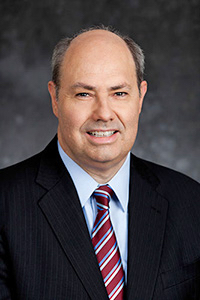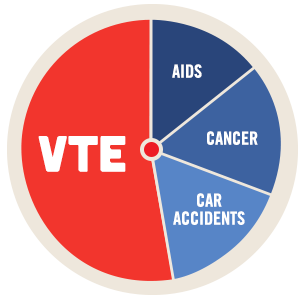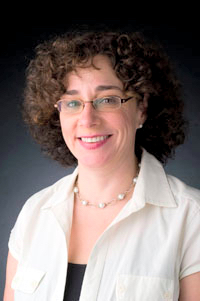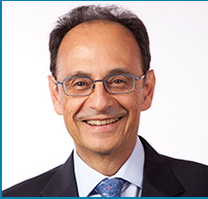Canadian National Research Network On Venous Thromboembolism Marks World Thrombosis Day

October 13 is World Thrombosis Day, an event that increases global awareness and focuses attention on the often overlooked and misunderstood disease of thrombosis as an urgent and growing health problem.
In recognition of World Thrombosis Day and the seriousness and prevalence of venous thromboembolism (VTE), the Montreal, Canada based Canadian Institutes of Health Research (CIHR), the Fonds de recherche Quebec Santé (FRQS), and a consortium of public and private funders, including the Lady Davis Institute (LDI) at the Jewish General Hospital (JGH) and McGill University, and The Ottawa Hospital and University of Ottawa, have announced a (Can) $5.2 million initiative aimed at reducing VTE occurrence, improving diagnosis and therapeutic management, augmenting the safety of anticoagulant delivery, and enhancing the quality of life of those impacted by VTE. The consortium will invest the $5.2 million in funding over five years to establish the Canadian Venous Thromboembolism Clinical Trials and Outcomes Research Network (to be known as CanVECTOR).
 Dr. Gary Raskob, Dean of the College of Public Health at the University of Oklahoma, and chair of the Steering Committee for World Thrombosis Day, says: “CanVECTOR will make major contributions to reducing premature death from VTE. This visionary partnership exemplifies the spirit of the World Thrombosis Day movement by bringing together public and private partners, government agencies and private funders, universities and health systems, health professionals and patients, all working toward the common goal of reducing the burden of disease from thrombosis and improving global health.”
Dr. Gary Raskob, Dean of the College of Public Health at the University of Oklahoma, and chair of the Steering Committee for World Thrombosis Day, says: “CanVECTOR will make major contributions to reducing premature death from VTE. This visionary partnership exemplifies the spirit of the World Thrombosis Day movement by bringing together public and private partners, government agencies and private funders, universities and health systems, health professionals and patients, all working toward the common goal of reducing the burden of disease from thrombosis and improving global health.”
CanVECTOR’s objectives include reducing VTE occurrence, improving VTE diagnosis and therapeutic management, improving the safety of anticoagulant delivery, and enhancing the quality of life of those impacted by VTE, both in Canada and globally.
 VTE is a common, potentially fatal yet treatable condition and the third leading cause of cardiovascular mortality. Worldwide, one in four people die from causes related to thrombosis, and advocates say that without addressing this disease head on, we cannot meet the World Health Assembly’s global target to reduce premature non-communicable mortality by 25 percent by 2025. is a leading cause of death and disability worldwide. In Europe and the U.S. Venous thromboembolism claims more lives than AIDS, breast and prostate cancer, and motor vehicle crashes combined.
VTE is a common, potentially fatal yet treatable condition and the third leading cause of cardiovascular mortality. Worldwide, one in four people die from causes related to thrombosis, and advocates say that without addressing this disease head on, we cannot meet the World Health Assembly’s global target to reduce premature non-communicable mortality by 25 percent by 2025. is a leading cause of death and disability worldwide. In Europe and the U.S. Venous thromboembolism claims more lives than AIDS, breast and prostate cancer, and motor vehicle crashes combined.
Dr. Susan Kahn and Dr. Marc Rodger are co-principal investigators and directors of the project, the first of its kind in the world. Dr. Kahn is a senior investigator at the Lady Davis Institute and head of the Centre of Excellence in Thrombosis and Anticoagulation Care (CETAC) at the Jewish General Hospital in Montreal. Career Scientist Dr. Marc  Rodger, MD, FRCP(C), MSc is Chief and Chair of the Division of Hematology, and head of the Thrombosis Program at The Ottawa Hospital, and Chair in Venous Thrombosis, and a Professor in the Faculty of Medicine, Departments of Medicine, Epidemiology and Community Medicine and Obstetrics and Gynecology at the University of Ottawa. He is also a Senior Scientist at the Ottawa Hospital Research Institute, and holds a Faculty of Medicine Clinical Research Chair in Venous Thrombosis and Thrombophilia.
Rodger, MD, FRCP(C), MSc is Chief and Chair of the Division of Hematology, and head of the Thrombosis Program at The Ottawa Hospital, and Chair in Venous Thrombosis, and a Professor in the Faculty of Medicine, Departments of Medicine, Epidemiology and Community Medicine and Obstetrics and Gynecology at the University of Ottawa. He is also a Senior Scientist at the Ottawa Hospital Research Institute, and holds a Faculty of Medicine Clinical Research Chair in Venous Thrombosis and Thrombophilia.
Acute and short term therapy of VTE involves anticoagulants, and this therapy reduces recurrent VTE and death from recurrent VTE while on therapy, but is complicated by side effects of major bleeding and death from major bleeding. Optimal duration of anticoagulation in patients with unprovoked VTE is on one of the most important unanswered clinical questions. In a multi-national prospective cohort study exploring risk factors for recurrent venous thrombosis, Dr. Rodger developed a promising clinical decision rule, Men continue and HERDOO2 that segregates these patients into a low risk group (<6% VTE recurrence at 5 years) that likely should discontinue anticoagulants and a high risk group (>30% VTE recurrence at 5 years) that likely should continue anticoagulants. This rule is being validated this decision rule in a multi-national 45 centre cohort study of over 3000 unprovoked VTE patients (REVERSE II study). This and other work may lead to better pathophysiologic understanding of this disease and lead to new treatments and/or treatment approaches. Dr. Rodger is in the planning stages of an RCT examining statins, an exciting potential therapies that is simple, inexpensive, and safe, for secondary prevention of VTE in unprovoked VTE patients.
 Dr. Susan R. Kahn, MD, FRCPC, MSc (Epid) is Associate Director for Clinical Research at the Lady Davis Institute, and an internationally recognized researcher in venous thromboembolism. Her research activities primarily focus on the epidemiology of venous thromboembolism, specifically etiologic mechanisms and health outcomes. Peer-review funded projects currently underway include the study of long-term clinical, economic and quality of life outcomes after venous deep vein thrombosis and pulmonary embolism, the influence of inflammation and thrombophilia on long term adverse outcomes of deep vein thrombosis, the role of exercise training to treat the post-thrombotic syndrome, and a NIH/NHLBI funded multicenter trial of pharmacomechanical catheter-directed thrombolysis to improve long term outcomes after deep vein thrombosis.
Dr. Susan R. Kahn, MD, FRCPC, MSc (Epid) is Associate Director for Clinical Research at the Lady Davis Institute, and an internationally recognized researcher in venous thromboembolism. Her research activities primarily focus on the epidemiology of venous thromboembolism, specifically etiologic mechanisms and health outcomes. Peer-review funded projects currently underway include the study of long-term clinical, economic and quality of life outcomes after venous deep vein thrombosis and pulmonary embolism, the influence of inflammation and thrombophilia on long term adverse outcomes of deep vein thrombosis, the role of exercise training to treat the post-thrombotic syndrome, and a NIH/NHLBI funded multicenter trial of pharmacomechanical catheter-directed thrombolysis to improve long term outcomes after deep vein thrombosis.
A Professor of Medicine at McGill University and Tier 1 Canada Research Chair, Dr. Kahn a founding member of the Venous Thromboembolism Clinical Trials Organization (VECTOR), a national, collaborative research group, is also leading a number of multicenter clinical trials in long-term clinical, economic and quality of life outcomes after venous deep vein thrombosis and pulmonary embolism, the influence of inflammation and thrombophilia on long term adverse outcomes of deep vein thrombosis. She is a steering committee member, and chairs the Outcomes Committee, of the ATTRACT Study, a NIH/NHLBI-funded multicentre trial of pharmacomechanical catheter-directed thrombolysis to improve long term outcomes after deep vein thrombosis, and has served, since 2007, as Chair of the CIHR Randomized Controlled Trials grant committee. Locally, she is Director of the Jewish General Hospital Thrombosis Program and the McGill Fellowship in Thrombosis in Montreal.
“VTE is the second most common cardiovascular disorder after heart attack,” Dr. Kahn points out. “Pulmonary embolism, a blood clot to the heart or lungs the most serious form of VTE is the third-leading cause of cardiovascular death. Ten percent of patients who suffer pulmonary embolism will die rapidly prior to diagnosis, which highlights the importance of preventing VTE. Moreover, VTE imposes life-long burdens on many patients because it frequently becomes chronic, including recurrent episodes of VTE, the post-thrombotic syndrome (PTS), and chronic thromboembolic pulmonary hypertension.”
The cost to treat a single case of acute VTE is more than (CAN)$10,000, and the estimated total burden of VTE and its complications in Canada is at least (CAN)$600 million per year, not including such indirect costs as loss of productivity that affects patients, families, and society in general. Such data underscores the value of the investment being made into the CanVECTOR Network.
“As prevalent as VTE is, there are important gaps in our knowledge that only focused research can hope to fill,” says Dr. Rodger. “We have yet to identify causal factors for first and recurrent VTE. We observe inconsistent use of proven measures to prevent VTE, as well as limited community expertise in diagnosing and managing VTE and its complications, and limited knowledge of VTE among the general public. There is an urgent need to improve therapeutic options. While anticoagulant drugs have proven to be effective, they are associated with severe adverse effects namely, life-threatening bleeding. Moreover, the demands they impose on patients include injections, frequent laboratory monitoring, and lifestyle and diet modifications. New oral anticoagulants have recently been developed, but their long-term effectiveness and safety have yet to be determined.”
The CanVECTOR project includes sixty-one investigators based at universities spread across nine Canadian provinces. Among the participants are clinician-scientists, basic researchers, nurses, health economists, methodologists, as well as patient partners. It is rather innovative to include patients when designing research questions, but crucial as they have unique insight into the aspects of disease that are of most concern to their particular circumstance.
“We are determined to focus on questions that can be translated into clinical practice so that our research will have a direct impact on public health,” says Dr. Kahn.
 “The FRQS is extremely proud to contribute financial support to this important research initiative into venous thromboembolism,” observes FRQS Scientific Director Dr. Renaldo Battista.
“The FRQS is extremely proud to contribute financial support to this important research initiative into venous thromboembolism,” observes FRQS Scientific Director Dr. Renaldo Battista.
World Thrombosis Day
Recognized annually on 13 October, World Thrombosis Day (WTD) is marked by hundreds of educational events in countries around the world, placing a global spotlight on thrombosis as an urgent and growing health problem.
October 13 is the birthday of pioneer in the pathophysiology of thrombosis Rudolf Virchow. A German physician and pathologist, Dr. Virchow developed the concept of “thrombosis” and advanced our understanding of this condition. To learn more, visit the Berliner Medizinhistorisches Museum der Charitè (Berlin Museum of Medical History), formerly the Rudolf Virchow’s Pathological Museum.
World Thrombosis Day WTD seeks to increase global awareness of thrombosis, including its causes, risk factors, signs/symptoms and evidence-based prevention and treatment. Ultimately, WTD strives to reduce death and disability caused by the disease, and supports the World Health Assembly’s global target of reducing premature deaths by non-communicable disease by 25 percent by 2025, as well as the World Health Organization’s global action plan for the prevention and control of non-communicable diseases between 2013 and 2020.
WTD objectives include:
• Highlight the burden of disease (thrombosis in general) and highlight the need for action, specifically underscoring the unrecognized threat and serious consequences (morbidity and mortality) related to venous thromboembolism (VTE).
• Increase public awareness of the significance, risks, signs and symptoms of VTE.
• Empower individuals to seek medical attention promptly if they have signs or symptoms, and to engage their healthcare providers in discussions about appropriate diagnosis, prevention and treatment options.
• Galvanize organizations in countries across the globe to conduct appropriate and aligned campaigns in their countries and regions.
• Begin the process of advocating for “systems of care” to properly prevent, diagnose and treat VTE.
For more information, visit:
https://www.worldthrombosisday.org/
Sources:
World Thrombosis Day
McGill University
Lady Davis Institute
The University of Ottawa
The Canadian Venous Thromboembolism Clinical Trials and Outcomes Research Network (CanVECTOR)








